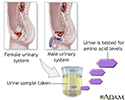Aminoaciduria
Amino acids - urine; Urine amino acids
Aminoaciduria is an abnormal amount of amino acids in the urine. Amino acids are the building blocks for proteins in the body.
How the Test is Performed
A clean-catch urine sample may be needed. This is often done at your health care provider's office or health clinic.
How to Prepare for the Test
Most of the time, you do not need to take special steps before this test. Make sure your provider knows all of the medicines you recently used. If this test is being done on an infant who is breastfeeding, make sure the provider knows what medicines the nursing mother is taking.
How the Test will Feel
The test involves only normal urination.
Why the Test is Performed
This test is done to measure amino acid levels in the urine. There are many different types of amino acids. It is common for some of each kind to be found in the urine. Increased levels of individual amino acids can be a sign of a problem with metabolism.
Normal Results
The specific value is measured in mmol/mol creatinine. The values below represent normal ranges in 24 hours urine for adults.
Alanine: 9 to 98
Arginine: 0 to 8
Asparagine: 10 to 65
Aspartic acid: 5 to 50
Citrulline: 1 to 22
Cystine: 2 to 12
Glutamic acid: 0 to 21
Glutamine: 11 to 42
Glycine: 17 to 146
Histidine: 49 to 413
Isoleucine: 30 to 186
Leucine: 1 to 9
Lysine: 2 to 16
Methionine: 2 to 53
Ornithine: 1 to 5
Phenylalanine: 1 to 5
Proline: 3 to 13
Serine: 0 to 9
Taurine: 18 to 89
Threonine: 13 to 587
Tyrosine: 3 to 14
Valine: 3 to 36
Normal value ranges may vary slightly among different laboratories. Talk to your provider about the meaning of your specific test results.
The examples above show the common measurements for results for these tests. Some laboratories use different measurements or may test different specimens.
What Abnormal Results Mean
Increased total urine amino acids may be due to:
- Alkaptonuria
- Canavan disease
- Cystinosis
- Cystathioninuria
- Fructose intolerance
- Galactosemia
- Hartnup disease
- Homocystinuria
- Hyperammonemia
- Hyperparathyroidism
- Maple syrup urine disease
- Methylmalonic acidemia
- Multiple myeloma
- Ornithine transcarbamylase deficiency
- Osteomalacia
- Propionic acidemia
- Rickets
- Tyrosinemia type 1
- Tyrosinemia type 2
- Viral hepatitis
- Wilson disease
Considerations
Screening infants for increased levels of amino acids can help detect problems with metabolism. Early treatment for these conditions may prevent complications in the future.
References
Dietzen DJ. Amino acids, peptides, and proteins. In: Rifai N, ed. Tietz Textbook of Clinical Chemistry and Molecular Diagnostics. 6th ed. St Louis, MO: Elsevier; 2018:chap 28.
Kliegman RM, St. Geme JW, Blum NJ, Shah SS, Tasker RC, Wilson KM. Defects in metabolism of amino acids. In: Kliegman RM, St. Geme JW, Blum NJ, Shah SS, Tasker RC, Wilson KM, eds. Nelson Textbook of Pediatrics. 21st ed. Philadelphia, PA: Elsevier; 2020:chap 103.
Riley RS, McPherson RA. Basic examination of urine. In: McPherson RA, Pincus MR, eds. Henry's Clinical Diagnosis and Management by Laboratory Methods. 24th ed. Elsevier; 2022:chap 29.
Review Date: 5/2/2021
Reviewed By: Anna C. Edens Hurst, MD, MS, Associate Professor in Medical Genetics, The University of Alabama at Birmingham, Birmingham, AL. Review provided by VeriMed Healthcare Network. Also reviewed by David Zieve, MD, MHA, Medical Director, Brenda Conaway, Editorial Director, and the A.D.A.M. Editorial team.











